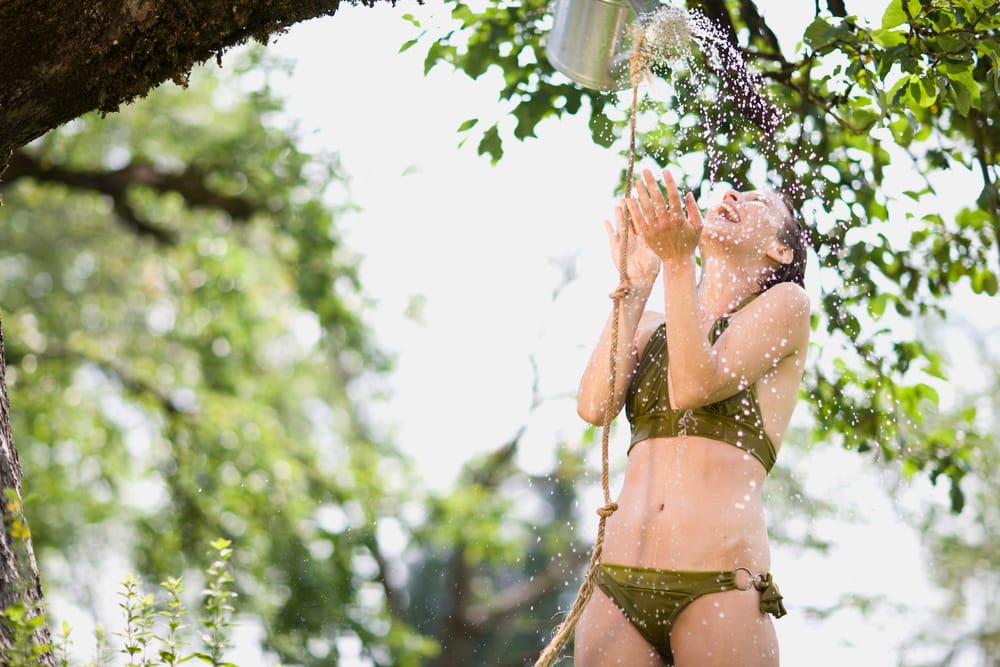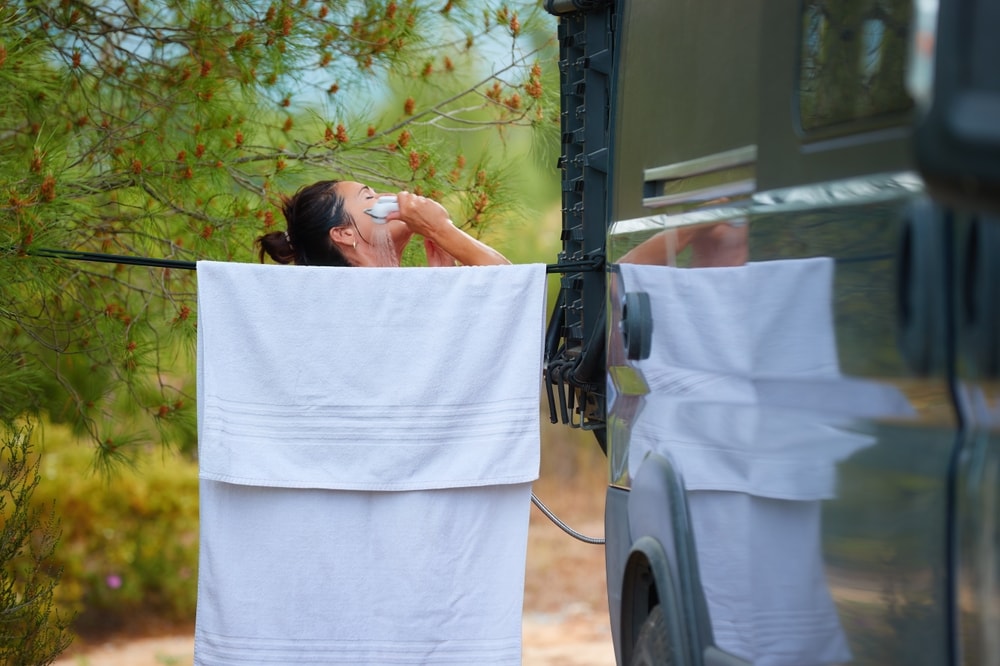Outforia Quicktake: Key Takeaways
- Showering while camping requires careful consideration of your surroundings, privacy needs and potential risks.
- Wild swimming in a lake or stream can be refreshing, but always be aware of dangers like cold water, strong currents, and contaminated water.
- Sponge baths can be a good alternative, especially if you collect wild water and heat it over a campfire. Use a flannel or sponge, and biodegradable soap to clean yourself.
- If you’re camping with a car, consider a roof-mounted water tank for showers. In a public campground without good facilities, look for local gyms or swimming pools that offer showers.
- To ensure privacy while showering, consider wearing swimwear, using a privacy tent, a changing towel or robe, or investing in a more spacious shower tent.

Many of us have been in that unique situation when camping for more than two days. The point at which you realize that you need to take a short break from all the excitement and activity to tend to your own personal hygiene needs.
What you do about this depends very much on where you are.
Are you wild camping or in a campground? How much privacy do you have? Are there trees to hang a gravity-fed shower from? Do you want a hot shower, or will you settle for a cold one? Maybe you even want a bath.
Here we explore the world of washing yourself while camping.
How To Wash While Wild Camping
The great thing about wild camping is that you quite often have a lot of privacy. Something you wouldn’t have in a campground.
Wild swimming

My favorite way to wash while wild camping is to find a suitable lake, reservoir, or stream and dive in for a nice, cool dip.
Wild swimming, or open-water swimming, is enjoying a huge boost in popularity. There’s nothing like swimming with dragonflies, fish, and waterbirds.
You do need to be aware of the risks before jumping in. If it’s an area well known for wild swimming, there are usually other people there that could help you in a crisis. The water is known to be fairly clean and free from debris.
If you don’t know the area, be cautious. Hazards to watch out for are:
- Strong currents (check for eddies and strange water patterns on the surface)
- Contamination from heavy metals, industry, sewage, etc
- Very cold water
- Cramps and difficulties while swimming
- Getting caught in underwater objects or weeds
- Animal attack (crocodiles, piranhas, or parasites)

Here are some things you can do to make your wild swim safer:
- Use a tow float. This attaches around your waist. You can grab onto it and hold yourself out of the water if you get tired or injured. You can store your phone in a waterproof pocket in some of them.
- Go with other people.
- Research the lakes and water bodies before your trip. Find out their history. Were they used in industry? Are they downstream from a sewage plant?
- Use your senses. If the water smells strange or nothing is growing or living in it, beware. If there is a lot of algae, it could be sewage or fertilizer runoff that is causing it.
- Don’t drink the water, and reconsider going in if you have open wounds.
- Check with locals to see if there are any hazards.
While there is an element of risk in everything, it’s better to minimize the risk.
Sponge bath

If total immersion in wild water isn’t your thing or you can’t swim, try collecting some wild water for a sponge bath. You only need a large saucepan of water and a flannel or sponge. You can also buy flannel gloves.
- Heat water on the camp stove or over the fire, making sure it doesn’t get too hot.
- If you are heating it on the fire, use a cooking tripod or a campfire trivet. It can be dangerous to balance a pot of hot water on burning logs. As logs burn through, they will suddenly give way, and you will be dodging boiling water.
- Allow to cool. Soak flannel or sponge in the water pan.
- Find a private place behind a bush (or the door of your car with a towel hung over it.)
- Strip off.
- Rub all over with the wet flannel.
- Rub biodegradable soap all over.
- Soak a sponge or flannel and rub it all over you again. Tip the rest of the water over your head for the grand finale.
You will be amazed at how much dirt you can get off and how fresh you can feel. I have washed this way for about 10 years on my narrowboat, and even though I have a shower now, I still do sponge baths as they are so economical with water.
You do need another saucepan of water to wash your hair, though.
Bringing your own water to the car shower

If you really don’t want to use wild water, perhaps because it is polluted, you can bring your own water. This is a lot more practical when car camping, as water is very heavy, and it’s a much better option to let your vehicle do the work.
You can buy a water tank that fits on the roof of your car, saving space inside. These can be pressurized too, using an electric or manual pump.
This works well with the ‘car door’ privacy tip I mentioned earlier. You can put a shower attachment on the roof tank and shower straight off the roof of the car.
You may also like: Smell Fresh in the Wilderness: How to Clean a Tent that Smells
How To Wash In a Campground

The trickiest part of washing in a public campground is the lack of privacy. Usually, campground owners will provide campground showers. Check before you go. More remote sites may not have these facilities.
There’s no guarantee these will work, however, or if they do, they may not be warm. Have a backup plan ready, like a privacy tent and a wash bowl.
Leisure centers, gyms, and swimming pools have showers you can use. Sometimes public toilets have showers.
You may also like:
How to Get Privacy
Even if you are an exhibitionist, in some countries it is illegal to get naked in public. So, what can you do to get some much needed privacy?
Wear swimwear

While we would all rather be naked, swimwear is the next best thing when it comes to washing. A few discreetly placed shower jets are usually enough to get your covered parts clean.
Privacy tent

These tall, narrow tents are perfect for family camping, large expeditions, and events. They can be used as portable toilets or washrooms. They fold down and pack up small.
If you are hiking, it will be slightly heavier and bulkier to carry. They are very economical, but also very basic.
You can stand up in them to get dressed, too. Which is handy for those camping in small tents. Amusingly, this person below has felt the need for one in the middle of the Nevada wilderness.
Changing robe

You can wear a changing towel like a robe. It’s much easier to keep your modesty intact while taking off and putting on your swimsuit.
With a standard towel, you are always doing an awkward dance trying to hold your towel up with one hand.
If there’s not enough privacy, you can wash underneath your changing robe with a flannel or sponge. Even if people are right next to you chatting away, they won’t see anything.
Shower tent

The shower tent is more spacious than the privacy tent. However, it is much more expensive at $191 to $255.
It has a draining mat and vents to allow moisture to escape. It also has a shower hook, so you can stand up straight and use both hands to wash your hair. The shower tent can be adapted for use on the beach as a changing room.
It can be put up and taken down in 60 seconds.
You may also like: How To Make A Camping Toilet
Camping Hygiene Hacks

Want to know some crafty personal hygiene hacks? Make sure you check out the list below.
Where To Shower When Car Camping

When traveling in a car or small vehicle, how do you get a wash?
- If you don’t want to stay in a campground with showers, try asking if you can use the camp showers for a small fee. Some campgrounds do this.
- Truck stops usually have pay-per-use showers.
- Public beaches have showers. They will likely be cold, though.
- Swimming pools, gyms, and leisure centers have showers if you use the facilities.
- It’s easy to find quiet stretches of water for wild swimming if you’re traveling by car.
If you are right out in the wilderness and water is scarce, try washing in a more economical way, like with a sponge.
Navy style is another option. Wet yourself, then turn off the water. Lather yourself with soap. Rinse it off. Don’t leave the water running.
You may also like: Camping Rules: Does Camping Have Unwritten Rules?
FAQs

Does soap pollute the environment?
Petrochemical soap does pollute the environment. It releases phosphates, antibacterial and antifungal agents, fragrances, and preservatives. All of which can harm aquatic organisms and destroy food chains.
What is biodegradable soap made from?
Biodegradable soap is made from animal or vegetable products instead of petroleum-based products. Most are made out of vegetable products like palm oil, coconut oil, and lye. They don’t contain surfactants and toxins like parabens and sulfates.
Is it necessary to shower while camping?
While personal hygiene may be more challenging in a camping environment, showering can help you feel refreshed and clean, especially during longer camping trips or when staying in hot and humid conditions.
What are some options for showering while camping?
There are a few options for showering while camping. These include using portable camping showers, solar showers, wet wipes, or even natural water sources like rivers or lakes if they are safe and permitted.
How does a portable camping shower work?
A portable camping shower typically consists of a water reservoir or bag that can be filled with water, a nozzle or showerhead, and sometimes a foot pump or gravity system to create water pressure. You hang the bag from a sturdy support, and by opening the nozzle, water is released for showering.








